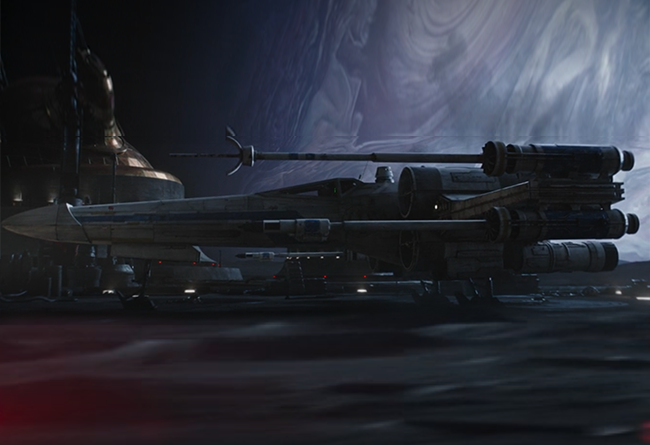Craft: Sienar Fleet Systems TIE/sa Bomber
Type: Dedicated light space bomber
Scale: Starfighter
Length: 7.8 meters
Skill: Starfighter piloting: TIE
Crew: 1
Crew Skill: Missile weapons 4D+1, starfighter piloting 4D, starship gunnery 5D
Cargo Capacity: 15 metric tons (bomb bay)
Consumables: 2 days
Cost: 150,000 (new), 75,000 (used)
Space: 6
Atmosphere: 295; 850 kmh
Hull: 4D+1
Sensors:
Passive: 20/0D
Scan: 35/1D
Search: 50/2D
Focus: 3/2D+2
Weapons:
2 Laser Cannons (fire linked)
Fire Arc: Front
Skill: Starship gunnery
Fire Control: 2D
Space Range: 1-3/12/25
Atmosphere Range: 100-300/1.2/2.5 km
Damage: 3D
Concussion Missiles Launcher (16 carried)
Fire Arc: Front
Skill: Missile weapons: concussion missiles
Fire Control: 3D+2
Space Range: 1/3/7
Atmosphere Range: 50-100/1/5 km
Damage: 9D
Background: The TIE/sa bomber, simply known as the TIE bomber or T/B, was a larger, less maneuverable TIE starfighter used for destroying large starships and pinpoint-precision bombing. The “sa” in the TIE bomber’s designation stood for “surface assault.”
Due to their distinctive dual-hull shape, TIE bombers came to be referred to occasionally as “dupes” or (albeit indirectly) “sitting ducks” by enemy pilots. The latter nickname was due to its bulky structure making it much slower and far less maneuverable than other TIE craft.
The TIE/sa bomber had two hulls next to each other; the starboard hull carried the pilot and the port carried a pair of general purpose warhead launchers, enabling them to carry a variety of weapons tailored for the mission. The bomber was much more heavily built-up than the “fighter”-series of TIEs; it carried more sophisticated sensors to penetrate capital ship jamming and SFS P-s4 twin ion engines powered by a SFS I-a2b solar ionization reactor to allow a full payload to be carried at a reasonable speed. The ordnance hull could also be swapped for a passenger cabin instead of heavy weapons.
An Imperial Star Destroyer generally carried a squadron of 12 bombers. The TIE bomber was capable of carrying at least one of the following payloads, for a total of 15 metric tons: sixteen concussion missiles, twelve proton torpedoes, eight proton rockets, six space mines, four proton bombs, sixty-four thermal detonators, thousands of propaganda pamphlets, or supply canisters. Guided concussion missiles/proton torpedoes were generally carried nearing the inside of the second hull, orbital mines were placed in a rack above the missile rack, while proton bombs and orbital mines were generally near the exterior of the hull, near the bomb-drop chute. In addition, the second hull also possessed an ordnance maneuvering arm that retrieves and loads armaments. Its fixed armament was two wing-mounted laser cannons.
The bomber was agile enough to deliver devastating strikes with surgical precision; as shown by a mission when a group of these craft destroyed a Rebel-occupied tower in the middle of a crowded city while leaving the surroundings untouched.
Nonetheless, the bomber was slower and less maneuverable than the TIE/LN starfighter. Like most mass-produced TIEs, it lacked shields, though it did partly compensate by having a stronger hull. This was largely the reason why one of its nicknames by Rebel pilots was “sitting duck,” as they were considered easy prey. Standard Imperial doctrine required that bombers be escorted to target by other starfighters.
While not expected to engage enemy fighters in dogfights due to their slower speed and agility, TIE Bombers could target them from a standoff distance with their large magazines of concussion missiles. During the conflict at Mylok IV, a squadron of Demetrius Zaarin’s bombers held off large numbers of Nharwaak and Rebel Y-wings, allowing the Imperials to aid the Habeen in evacuating their base. Due to a shortage of TIE Interceptors during the pacification of the Pakuuni system, Maarek Stele thrust his bomber into the space superiority role against Rebel and pirates, once defending Thrawn’s craft from an attack while he visited the newly completed outpost NL-1. Imperial commanders used bombers to counter Rebel B-wing starfighters, with the TIEs launching their missiles directly into their flightpaths.
The TIE Bomber’s lack of shields was exploited by enemy forces during the Sepan Civil War. There, the Ripoblus conducted an attack on the Dimok Science Station Youst spearheaded by six Assault Transports. The station’s defending fighters, consisting of Z-95 Headhunters and Delta-class JV-7 escort shuttles, quickly fell victim to the turrets of the ATR-6 that they were trying to attack. When Admiral Harkov’s forces entered the area to repel the Ripoblus, they deployed TIE Bomber to take out the ATR-6s from a safe distance with proton torpedoes. Imperial pilots discovered that a full-strength ATR-6 could survive even three torpedo hits, with several Bombers lost trying to finish off the injured ATR-6 with laser cannon fire. Maarek Stele opted wisely to replace his payload with proton rockets, which required more careful aiming, but one of these devastating warheads was enough to quickly destroy an ATR-6. Near the end of the campaign, while covering the transfer of TIE Avengers, Stele distracted the gunners of the Dimok cruiser Ben Het so bombers could safely conduct their torpedo runs against it, resulting in its destruction.
The TIE Bomber, unlike other TIE models, was also equipped with life support systems and a cockpit ejection seat, although pilots still wore flight suits in case of an emergency.





